Choosing the right university is one of the most important decisions you’ll ever make—and it can feel overwhelming. With so many options, factors, and opinions to consider, it’s easy to get lost in the process. This in-depth guide will walk you through every step of how to choose a university, helping you make a decision that’s not only smart and informed, but truly right for you.
Introduction: The Importance of Choosing the Right University
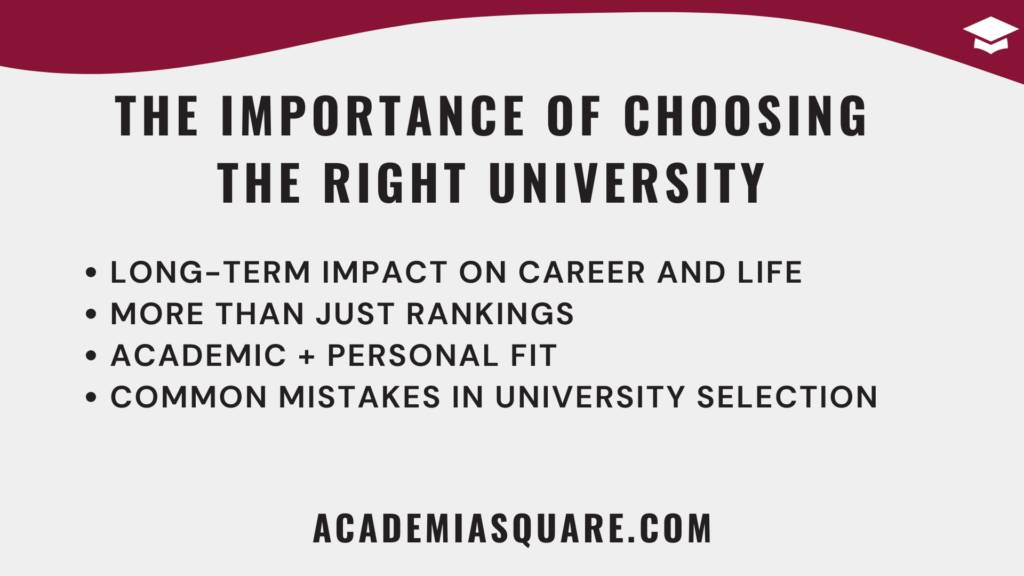
Deciding where to pursue higher education is one of the most significant choices a student will make. Whether you’re coming from high school or transferring from another institution, how to choose a university is a question that shapes not just the next few years, but potentially your entire life path. From academic success to career opportunities and personal growth, the university you attend plays a vital role.
With so many options available globally and the rise of online programs, students can feel overwhelmed. A recent study from the Higher Education Research Institute found that over 35% of college students consider transferring because their initial choice didn’t meet expectations. This points to a widespread lack of informed decision-making when selecting a university.
Many students focus too heavily on a school’s brand or rank, overlooking other equally important factors such as teaching quality, campus culture, or available support services. The goal of this guide is to provide a research-backed, easy-to-follow approach to help you evaluate your options thoroughly and with confidence.
Why Learning How to Choose a University Matters
Choosing the right university is not just about prestige or rankings. It’s about finding a place where you can thrive academically, socially, and emotionally. The wrong choice can lead to disengagement, poor grades, and even dropping out. On the other hand, the right fit can enhance motivation, lead to better grades, and open doors to exciting career paths.
According to the National Center for Education Statistics, students who feel aligned with their institution are more likely to complete their degrees on time. This means your university should support your learning style, offer relevant academic programs, and provide an environment where you feel you belong.
Key Factors to Consider When Choosing a University
Before diving into university brochures or rankings, students should pause and reflect on their individual needs. Every learner is different, and understanding what matters most to you can guide your search in a more meaningful direction.
- Academic Goals: What do you want to study? Does the university offer strong programs in your area of interest?
- Learning Environment: Do you prefer large lectures or small discussion-based classes? Urban or rural campuses?
- Support Systems: Are there academic advisors, mental health resources, and career services available?
- Affordability: Can you manage tuition and living expenses? What kind of financial aid is offered?
- Long-term Outcomes: What are the graduation and employment rates for your program of interest?
Being intentional with your university choice helps you avoid the common pitfalls that many students face. It also prepares you to ask the right questions, whether during campus visits, virtual tours, or when speaking with admissions counselors.
How to Use This Guide on Choosing a University
This blog post is built to be more than just generic advice. It brings together strategies from educational psychology, student surveys, and university research to give you a decision-making framework that’s practical and effective.
You’ll explore everything from assessing your strengths and preferences, to comparing costs and facilities, all while keeping academic success in mind. Each chapter is designed to help you make a choice that leads to a fulfilling university experience—one where you can grow intellectually, socially, and professionally.
As you move forward, remember: learning how to choose a university isn’t just a task to check off. It’s an investment in your future, deserving of thoughtful reflection and strategic planning. Let’s begin that journey.
Self-Assessment: Understanding Your Goals and Preferences
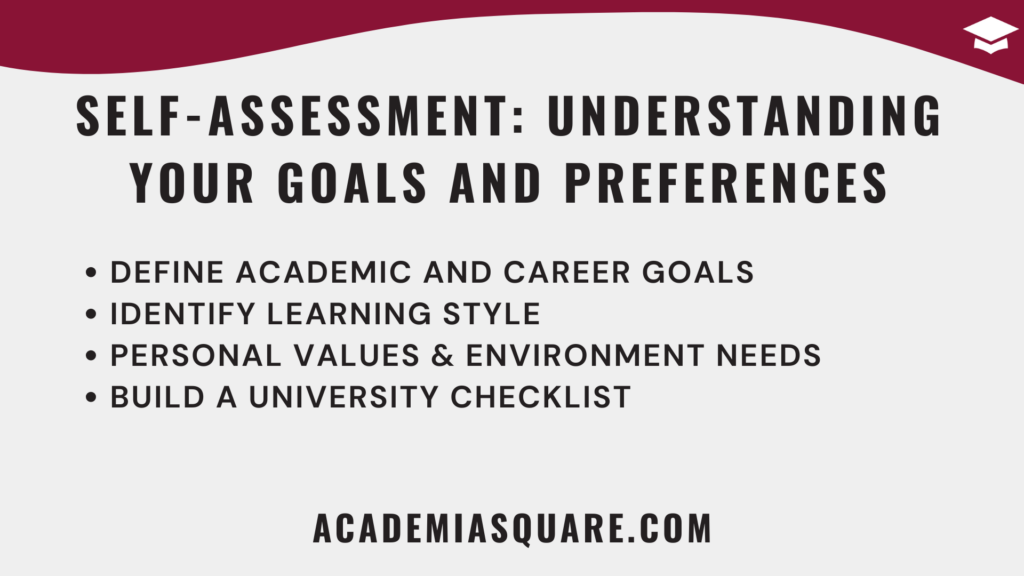
Before exploring brochures, rankings, or campus tours, take a step back. How to choose a university starts with understanding yourself. Knowing your academic interests, personality, strengths, and long-term goals provides a foundation for making the right decision. Without this clarity, it’s easy to get swayed by superficial factors like name recognition or peer pressure.
Self-assessment isn’t just about choosing a major—it’s about identifying the type of environment where you’ll thrive. Do you enjoy structure or flexibility? Are you more productive in quiet, academic-focused campuses or socially vibrant ones? Understanding these traits will guide you to institutions that align with your identity, not just your resume.
Clarifying Your Academic and Career Aspirations
Your career goals—even if not fully defined—can help you eliminate schools that won’t support your ambitions. If you’re drawn to research, look for universities with strong labs and faculty support. Interested in entrepreneurship? Consider schools near tech hubs or those with strong business incubators.
Start by asking yourself:
- What subjects or topics excite me most?
- Where do I see myself in 5 to 10 years?
- Do I want to specialize early or explore broadly?
- What kind of industries am I curious about?
Remember: You don’t need to have all the answers. Even a general direction can help you make more focused university choices.
Understanding Your Learning Style and Study Habits
Knowing how you learn best is key to choosing the right university. Are you an independent learner, or do you benefit from small, guided discussions? Some universities emphasize research and autonomy; others support students with structured, closely monitored learning environments. Identifying your learning style helps you find programs that align with how you absorb and apply knowledge—leading to better grades and less academic stress.
Considering Lifestyle and Social Needs
Academic fit is crucial, but don’t underestimate personal preferences. You’ll likely be living at or near the university for several years. Think about whether you want to study in a bustling city, a suburban area, or a rural town. Consider climate, distance from home, diversity, political atmosphere, and availability of social activities or faith-based communities. These elements contribute deeply to your overall well-being and sense of belonging.
Build Your Personal University Checklist
Once you’ve reflected on your goals and preferences, write down what’s most important to you in a university. Use the checklist to filter your search and avoid wasting time on schools that don’t fit.
- Top 3 academic interests
- Preferred class sizes and learning style
- Desired campus type (urban, suburban, rural)
- Must-have support services (tutoring, mental health, etc.)
- Social environment and extracurricular priorities
This self-knowledge gives you a compass for everything that follows. Choosing a university should not begin with Google—it should begin with you.
Academic Programs: Evaluating Course Offerings and Faculty
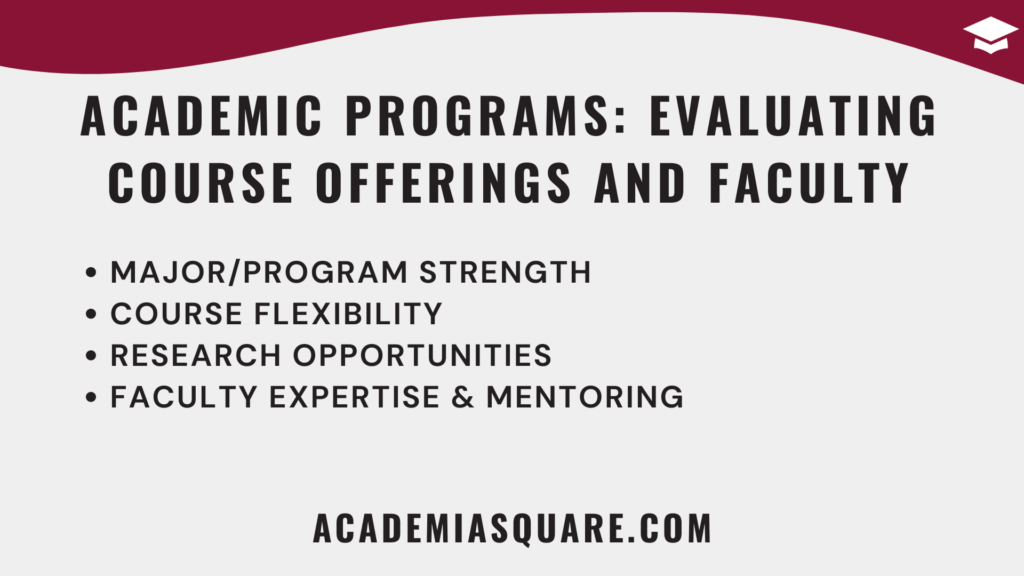
Once you understand your personal goals, it’s time to evaluate what universities offer in terms of academics. One of the most overlooked but critical steps in how to choose a university is assessing the strength of its academic programs. A prestigious school may not always have the best department for your specific interests.
Choosing the right academic fit ensures you’re engaged in your studies, which boosts performance, satisfaction, and long-term career outcomes. Universities vary widely in how they structure courses, promote interdisciplinary work, and support undergraduates in research and internships.
Researching the Strength of Your Intended Major
Not all programs are created equal. Some universities are known for engineering, others for liberal arts or medicine. Use program rankings—but don’t rely solely on them. Check graduation rates, course flexibility, faculty credentials, and research opportunities.
- Does the program offer specializations or concentrations?
- Are there hands-on experiences like labs, fieldwork, or clinics?
- What is the student-to-faculty ratio in your department?
- Can undergraduates assist in research or projects?
Explore syllabi and course descriptions online, or reach out to department heads with questions. This proactive approach can reveal whether the curriculum excites you or feels outdated and rigid.
Faculty Matters: More Than Just Credentials
Great teaching can be more valuable than great facilities. Look into faculty achievements, but also how accessible they are to students. Are they involved in mentorship? Do they lead student research or clubs?
RateMyProfessors and similar platforms can offer insight—but take them with a grain of salt. Better indicators include:
- Faculty-to-student mentoring programs
- Presence of teaching awards
- Recent publications or funded projects involving undergrads
Interdisciplinary Opportunities and Flexibility
Many students change their majors—some more than once. A university with flexible curriculum policies, cross-disciplinary programs, and support for double majors or minors can adapt to your evolving interests. This flexibility is essential for students still defining their career paths.
Check if schools allow course sampling, independent study, or project-based learning. This gives you more control over your academic experience and lets you build a customized, fulfilling path.
Linking Academic Quality to Real-World Outcomes
Does the department support internships, co-ops, or industry partnerships? Are students encouraged to publish, present, or network through academic conferences? These experiences are proven to increase job readiness and postgraduate success. According to the American Association of Colleges & Universities, students with high-impact academic experiences have better employment outcomes and report stronger skills after graduation.
When learning how to choose a university, go beyond name recognition. Focus on programs that match your intellectual curiosity, foster growth, and offer a gateway to meaningful career opportunities.
Location and Campus Environment
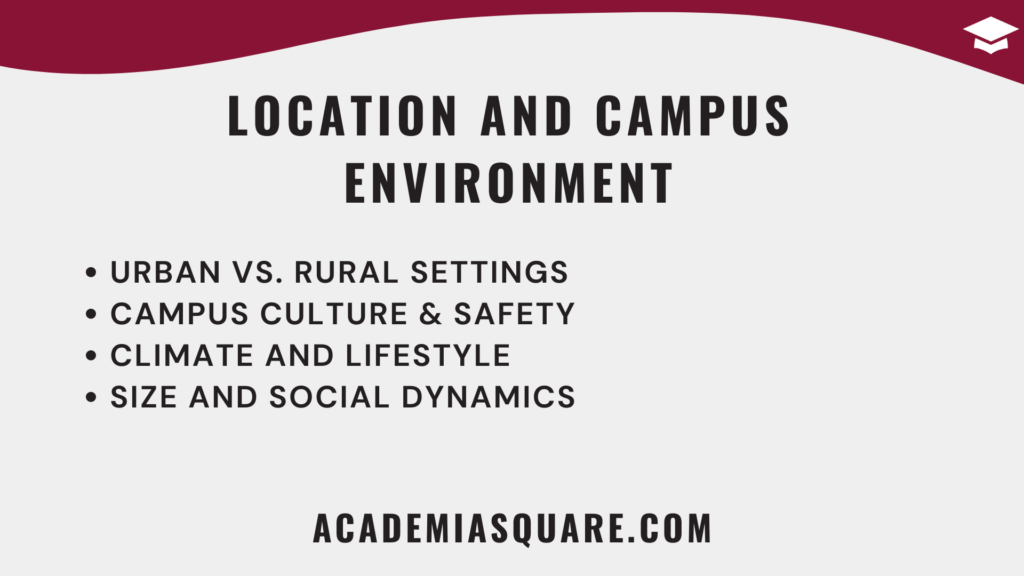
One of the most underrated yet deeply influential aspects in how to choose a university is its location and the type of campus environment it offers. These elements will shape your daily life, your social network, and even your mental health. While academic quality is crucial, where and how you live can directly affect your overall satisfaction and performance during your university years.
Are you energized by a fast-paced city or comforted by a quiet town? Would you prefer being close to home, or does studying abroad appeal to you? These questions help determine your ideal setting—not just in terms of aesthetics, but in how compatible a place is with your lifestyle and well-being.
Urban vs. Rural: What’s the Right Fit for You?
Urban universities are typically embedded in major cities, providing access to public transit, internships, networking events, and cultural experiences. However, they may also come with high costs of living and distractions. Rural or suburban campuses tend to offer close-knit communities, stronger bonds with professors, and a slower pace that some students find more conducive to academic focus.
- Urban: great for business, media, or tech careers due to nearby opportunities
- Suburban: blends quiet study with moderate access to city life
- Rural: offers peaceful settings and often stronger campus cohesion
Your decision should reflect where you feel most focused, supported, and safe. Even small preferences—like weather—can influence your mood and productivity.
Campus Size and Student Body Dynamics
Do you want to be part of a bustling student population or a more intimate academic community? Large universities often provide more diverse opportunities and facilities, while smaller schools offer personalized attention and stronger peer connections. Neither is better—only better for you.
Consider factors like:
- Student-to-faculty ratio
- Class sizes and access to professors
- Availability of student groups and social outlets
Social fit matters more than people think. Feeling disconnected on campus can impact your mental health and academic motivation.
Safety, Accessibility, and Quality of Life
Look into campus safety reports, access to healthcare, and public transportation options. Are there resources for students with disabilities? How diverse is the campus, and does it support underrepresented communities?
These are quality-of-life considerations that play a long-term role in your ability to thrive. A school may look amazing on paper, but if you don’t feel safe, included, or supported, it’s not the right fit.
Why the Right Environment Improves Your Grades
Studies in environmental psychology confirm that a supportive physical and social environment enhances academic focus and emotional well-being. Simply put, when students feel at home, they’re more likely to perform well, stay enrolled, and get better grades.
Choosing a university with the right location and atmosphere is not superficial—it’s strategic. It’s about building a lifestyle where learning feels natural and rewarding every day.
Financial Considerations: Tuition, Scholarships, and Cost of Living
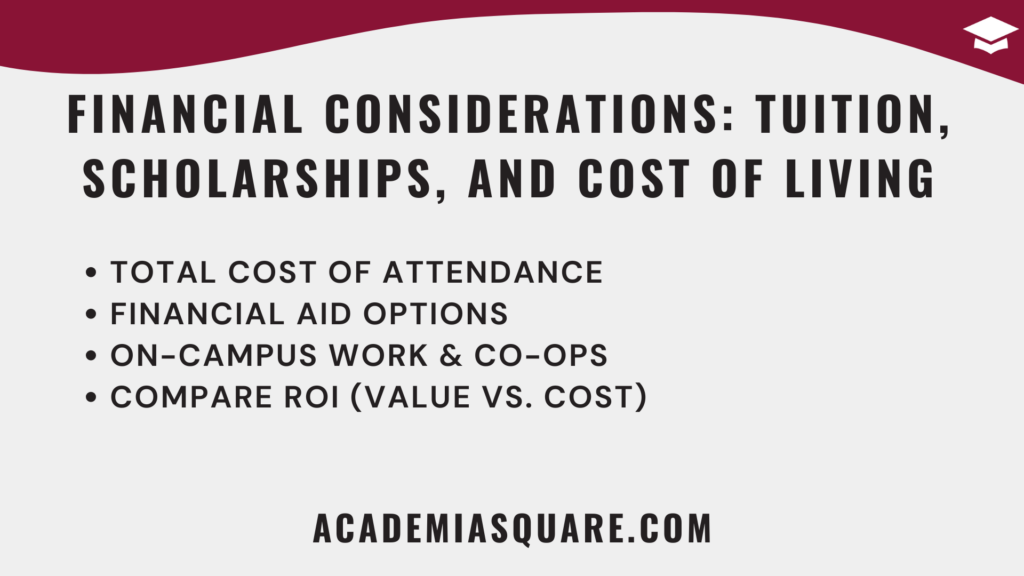
Let’s talk money—because ignoring it can lead to years of unnecessary stress. How to choose a university is not just about academics and prestige. It’s also about affordability and return on investment. A dream school with an unsustainable price tag can quickly become a nightmare if it leads to debt without sufficient earning potential.
Financial planning should be part of your university search from day one. Understanding what you can afford, where you can get help, and what the long-term costs look like will help you make a smarter, more confident decision.
Understanding Total Cost of Attendance
Don’t stop at tuition when comparing universities. You need to factor in all associated costs, including housing, food, transportation, books, fees, and personal expenses. Many universities provide cost calculators on their websites—use them to build a realistic picture of what each option will cost per year.
- Tuition and mandatory fees
- Room and board (on or off campus)
- Books, supplies, and technology
- Transportation and travel home
- Personal and miscellaneous expenses
Two schools with similar tuition rates can differ dramatically once you include housing and living costs. Always consider the full picture.
Scholarships, Grants, and Financial Aid
Explore both need-based and merit-based aid. Fill out the FAFSA (or your country’s equivalent) early and check each university’s financial aid deadlines and policies. Don’t assume elite universities are unaffordable—many offer generous aid packages, especially to high-performing students.
Also look for external scholarships from nonprofits, corporations, and local governments. It’s not uncommon to piece together funding from multiple sources.
Work Opportunities and Part-Time Options
Some universities offer on-campus jobs or cooperative education programs (co-ops), where students alternate between classroom study and full-time, paid work. These experiences reduce your net cost and improve post-graduation employment chances.
Ask about:
- Availability of student employment
- Internship programs tied to your major
- Career services and job placement rates
Being able to work without compromising your grades is a major asset—and a sign that a university supports financial sustainability.
Making Financial Sense of Your Decision
A lower-cost university that offers strong academics and high career placement can be a smarter choice than a high-cost school with minimal support. Consider not just what you’ll pay, but what kind of education and career future you’ll get in return. Think in terms of value, not just prestige.
Ultimately, how to choose a university includes understanding what you can afford without sacrificing your goals. Make decisions based on realistic numbers and long-term financial health, not emotions or hype.
University Rankings and Reputation
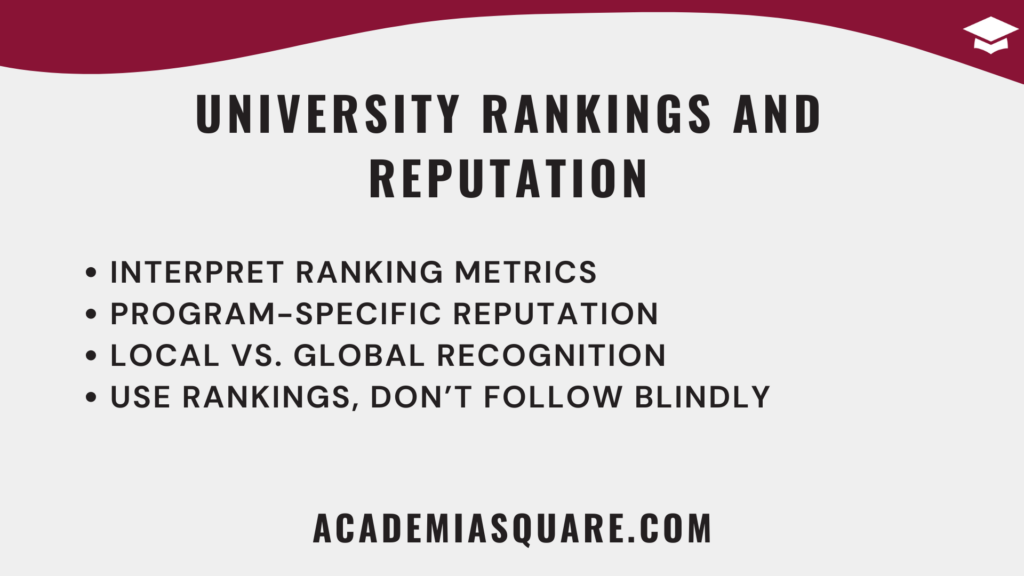
When considering how to choose a university, rankings and reputation inevitably come into the conversation. These metrics often dominate discussions among students, parents, and counselors. But while rankings can offer a general sense of a university’s standing, they shouldn’t be your sole decision-making tool. Prestige doesn’t guarantee the right academic or personal fit for you.
Understanding what rankings actually measure—and how to interpret them critically—can help you use them wisely without being misled by the hype. Reputation matters, but context is everything.
What University Rankings Really Mean
Major rankings like QS, Times Higher Education, and U.S. News & World Report assess universities based on a mix of criteria, including research output, faculty qualifications, international student ratios, and employer reputation. But these factors may not reflect what matters most to undergraduates—such as teaching quality or campus support systems.
- QS World University Rankings: emphasizes academic and employer reputation
- Times Higher Education: focuses on research influence and international outlook
- U.S. News & World Report: includes graduation rates, faculty resources, and alumni donations
These methodologies often favor large, research-intensive institutions, which may not be ideal if you’re seeking a close-knit learning environment or liberal arts experience.
When Reputation Matters—and When It Doesn’t
Reputation can influence job placement, especially in fields like law, finance, or consulting. A degree from a well-known university may open doors and lend credibility. However, many employers prioritize skills, experience, and personal drive over brand names. In tech, for instance, portfolios and practical experience often matter more than the university’s name.
Additionally, reputation may be regional. A mid-tier university in one country could have stronger job placement locally than a highly ranked international school that employers in your area barely recognize.
How to Use Rankings Strategically
Instead of chasing the highest-ranked schools, use rankings to identify schools with strength in your specific field of interest. Look at departmental rankings, research output, and alumni success in your desired industry.
You can also use rankings to compare schools on specific features:
- Student satisfaction and retention rates
- Faculty-student ratio
- Post-graduate employment data
- International opportunities and partnerships
Combining Reputation with Fit
High rankings mean little if you don’t thrive in that environment. Balance reputation with the other factors discussed in this guide—curriculum strength, campus culture, and support services. A lesser-known school with the right academic support can often lead to better grades and outcomes than a famous university where you feel lost or unsupported.
In summary, reputation is a useful data point—but it’s just one of many. Learn to read between the numbers and align university prestige with your personal goals, not the expectations of others.
Campus Facilities and Resources
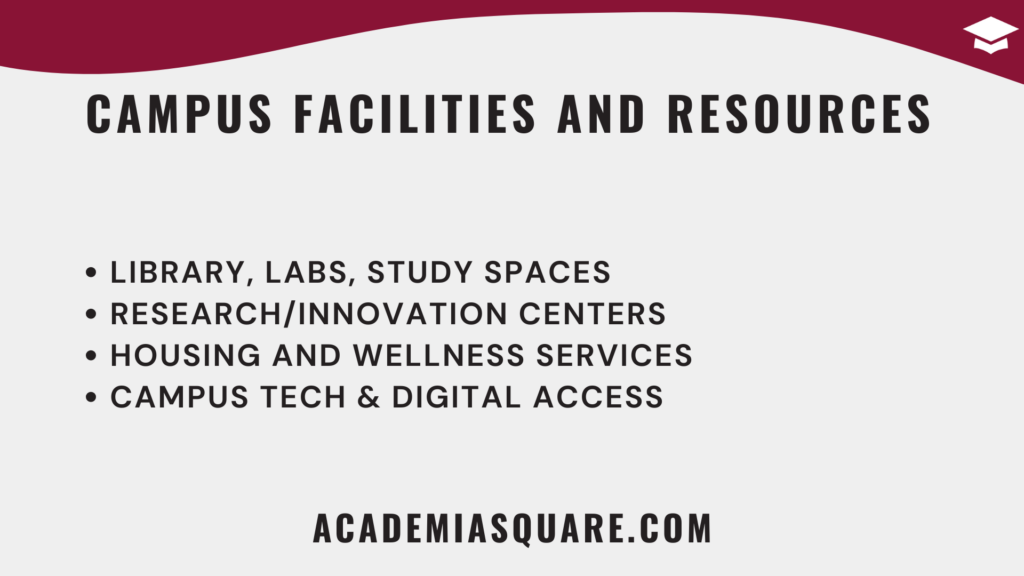
When thinking about how to choose a university, don’t just look at the course catalog or tuition fees—pay close attention to the campus facilities and the resources available to support your academic and personal growth. The right infrastructure can significantly enhance your learning experience, health, and overall success.
High-quality libraries, labs, tech centers, fitness spaces, and student hubs are more than just perks—they’re the tools you’ll use every day to succeed. Access to modern, well-maintained facilities can also reflect a university’s investment in student outcomes.
Academic Resources That Improve Learning
Universities that offer comprehensive academic resources empower students to take control of their education. Strong libraries, research labs, study centers, and tutoring services play a huge role in helping students get better grades and stay on track.
- Libraries: Evaluate the availability of study space, digital access, and academic databases
- Computer Labs: Especially important for majors requiring specialized software
- Tutoring & Writing Centers: Support services that help students overcome academic challenges
Ask whether these resources are available to all students or limited to certain programs or levels (e.g., graduate vs. undergraduate).
Research and Innovation Facilities
If you’re interested in STEM, social sciences, or creative arts, look into what kind of research or creation spaces are available. Innovation labs, 3D printing studios, video production rooms, and start-up incubators can all dramatically enrich your university experience and prepare you for post-graduation success.
Important questions to ask:
- Can undergraduates participate in research?
- Are there grants or funding for student-led projects?
- Is access limited or encouraged across disciplines?
Wellness, Housing, and Lifestyle Support
Facilities also include how well the university supports your physical and mental health. Look into gyms, counseling centers, dining options, and residence halls. The best universities view student well-being as central—not optional—to academic achievement.
Don’t overlook dormitory conditions, meal variety, or how accessible health services are. If you’re living on campus, this will be your home and your community for years.
Campus Tech and Digital Infrastructure
Modern learning relies heavily on digital tools. Ask about the university’s learning management systems (LMS), Wi-Fi quality, access to digital resources, and tech support. In an era where hybrid and online learning are increasingly normalized, a school’s tech ecosystem is critical to student success.
Choosing a university with strong facilities isn’t about luxury—it’s about maximizing your academic potential. A school that invests in your learning tools, wellness, and spaces is one that’s investing in your success. Don’t settle for less.
Student Life and Extracurricular Opportunities
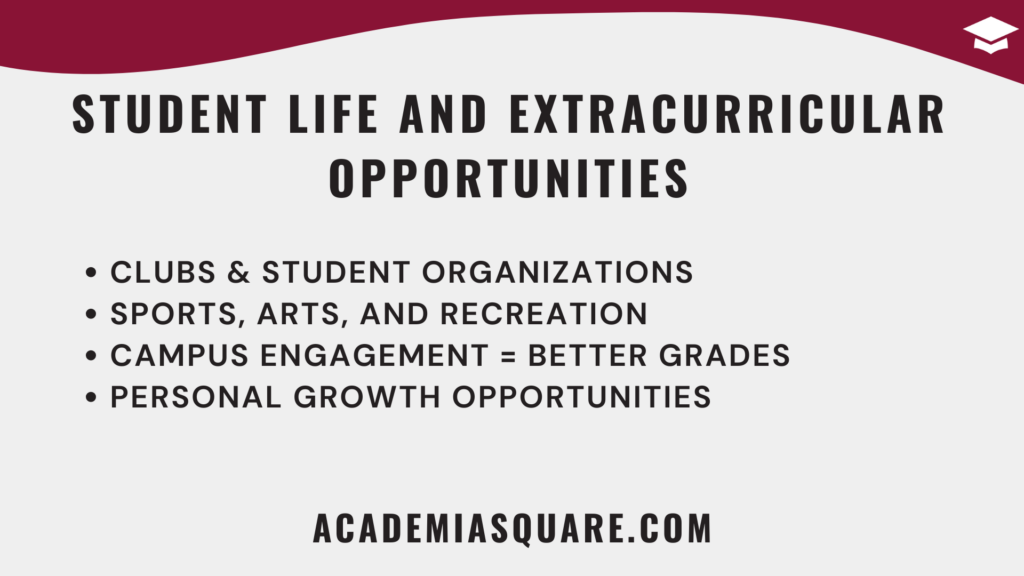
When evaluating how to choose a university, one often overlooked aspect is the richness of student life. Your college experience isn’t limited to lectures and exams—what happens outside the classroom plays a huge role in personal growth, networking, and mental health. A vibrant campus life contributes to a well-rounded education, providing opportunities for leadership, creativity, and fun.
Universities vary widely in their extracurricular offerings, and these differences can be the key to finding your ideal environment. A strong sense of community and access to engaging activities help students feel more connected, motivated, and ultimately more successful—academically and beyond.
Why Student Life Impacts Academic Success
Students who feel integrated into their campus community are more likely to stay enrolled, perform well, and graduate on time. According to the National Survey of Student Engagement, participation in extracurriculars correlates with higher GPAs and stronger soft skills like time management and teamwork.
Think of it as a feedback loop: the more involved you are, the more confident and competent you become—and the better you perform in class.
Clubs, Societies, and Leadership Roles
From academic clubs to cultural organizations and advocacy groups, involvement in student-run initiatives helps you explore interests, build a resume, and develop leadership skills. Many universities offer hundreds of options, including:
- Student government and leadership councils
- Debate teams, coding clubs, and entrepreneurship hubs
- Language, cultural, or identity-based organizations
- Volunteering and community outreach programs
Ask yourself: what type of student experience do I want? Then, explore whether each university can offer it.
Sports, Fitness, and Recreation
Whether you’re a varsity athlete or just want access to a great gym, physical activity options can impact your lifestyle and well-being. Look into intramural sports, fitness classes, outdoor clubs, and wellness programs. These contribute to stress relief and better mental health—both of which support academic performance.
Creative and Performing Arts
If you’re passionate about music, theater, film, or visual arts, find out what the university offers in terms of studios, performance spaces, and student showcases. Even if you’re not majoring in the arts, creative outlets enhance expression and personal fulfillment.
Ultimately, choosing a university with a dynamic student life will give you a more enjoyable and meaningful college experience. Don’t just think about classes—think about your lifestyle and community.
Support Services: Academic and Career Counseling
A university that supports you academically and professionally is one that prepares you for long-term success. How to choose a university should include evaluating what support systems are in place for when you hit roadblocks—because at some point, you will. The presence of strong academic advising, mental health resources, and career services can make all the difference.
Academic Advising and Tutoring
Effective academic advising ensures that students stay on track with course requirements, avoid registration issues, and have someone to turn to when they’re struggling. Ask whether each student is assigned an advisor, how often you can meet, and how personalized the guidance is.
- Is tutoring available for core subjects?
- Are writing centers and study skills workshops accessible to all students?
- Is there a structured system to identify and assist students at risk of failing?
Strong academic support can be the difference between average performance and consistently better grades.
Health, Wellness, and Mental Health Services
Student stress levels are at an all-time high. Universities must offer resources that go beyond academics. Does the school have counselors, peer support programs, or mental health days? Are services free or included in tuition? These questions matter. A supportive environment boosts retention, engagement, and well-being.
Career Centers and Internship Support
Choosing a university that invests in your career preparation can dramatically impact your employment outcomes. A good career center offers more than resume tips—it connects you with internships, runs job fairs, and helps you build a professional network.
- Internship placement rates
- On-campus recruiter visits
- Mentorship and alumni networking programs
Don’t wait until your final year to think about life after college. The earlier you start planning your career, the better positioned you’ll be for success.
Accessibility and Inclusion Services
Look into support for students with disabilities, first-generation college students, and international learners. Universities with strong inclusion policies often have better student satisfaction and success metrics. That’s a sign of a school that walks the talk when it comes to diversity and support.
Support services aren’t optional—they’re essential. A university that provides strong scaffolding will help you navigate the inevitable challenges of higher education more confidently.
Alumni Network and Career Outcomes
One of the most practical and often overlooked elements in how to choose a university is the strength of its alumni network and the real-world outcomes it delivers. After all, your education is not just about the years you spend on campus—it’s about the doors it opens when you leave.
Alumni success stories, mentoring programs, and employer connections can all give you a critical edge in launching your career. Universities with strong alumni networks often help students access internships, job leads, and insider industry knowledge. This matters—especially in competitive fields.
Alumni Engagement and Mentorship Programs
Some universities maintain active alumni networks that go beyond occasional newsletters. These institutions offer structured mentoring programs where students are paired with graduates working in their field of interest.
- Are alumni involved in career panels or networking events?
- Can you reach out to alumni for informational interviews?
- Does the university provide an online portal to connect with former students?
Mentorship can accelerate your career path, helping you make informed choices about internships, industries, and even grad school.
Career Placement Statistics and Job Readiness
Don’t just trust vague claims. Look at data: What percentage of graduates find employment within six months? What are the median starting salaries by major? Are students going on to respected grad programs or landing jobs with top employers?
These outcomes give you a sense of return on investment—and tell you whether the university’s education is respected in the real world.
Internships and Employer Partnerships
Universities with strong employer ties offer more internship opportunities, co-op programs, and on-campus recruitment events. These partnerships bridge the gap between theory and practice, ensuring you’re not just learning—you’re building experience and contacts.
Check if the university offers:
- Guaranteed internship placements for certain programs
- Global or national corporate partnerships
- Career development courses embedded in your degree
When universities help you build your professional identity early, you enter the job market not just as a graduate—but as a competitor.
Global Alumni Networks and Long-Term Value
If you plan to work internationally or pursue a global career, a wide-reaching alumni network can offer huge advantages. Some universities maintain chapters in major cities worldwide, allowing you to stay connected and supported well after graduation.
A university’s alumni network is a long-term asset. Don’t overlook it. Choosing a university with a powerful community of graduates can give you mentorship, confidence, and opportunity—well beyond the classroom.
Visiting Campuses and Virtual Tours
You’ve done your research, compared programs, and considered finances—but there’s nothing quite like experiencing a campus firsthand. A visit, whether in person or virtual, provides valuable context that no brochure or website can fully convey. When it comes to how to choose a university, this step allows you to connect emotionally and practically with a space that could be your home for years.
Visiting helps you evaluate the atmosphere, assess resources, and talk to current students. It can validate your top choices—or challenge them. And if traveling isn’t feasible, today’s virtual tours can offer surprisingly immersive alternatives.
Why Campus Visits Still Matter
Seeing a campus in person helps you move beyond marketing materials. You can observe classroom dynamics, cafeteria vibes, and whether students seem engaged or indifferent. Pay attention to how staff treat you—are they welcoming? Are your questions answered thoroughly?
- Attend a class or lecture if possible
- Visit dorms, libraries, labs, and recreation areas
- Talk to students about their experiences and challenges
- Explore the surrounding neighborhood or town
This on-the-ground insight provides a more holistic view of what your daily life would actually feel like on campus.
Making the Most of Virtual Campus Tours
Not everyone can travel, but that shouldn’t stop you from gaining a clear picture of the universities you’re considering. Many schools offer highly interactive virtual tours, student-led Q&A sessions, and online open days. These tools have grown in quality since the pandemic and can give you an effective sense of the campus environment.
Tips for virtual visits:
- Use a computer or tablet for better navigation and detail
- Join live Q&A sessions with faculty or admissions teams
- Watch recorded student testimonials and panel discussions
- Prepare questions just as you would for an in-person visit
Virtual tools aren’t perfect, but they do help you compare campuses side-by-side without leaving your home. Many students use them to narrow their list before planning physical visits.
What to Look for on Any Campus Tour
Regardless of format, your visit should answer specific questions:
- Does the campus layout feel manageable and well-organized?
- Are there quiet places to study and social spaces to unwind?
- Do support services appear accessible and well-used?
- Can you see yourself feeling safe and at home here?
Trust your instincts. Sometimes what “feels right” complements your logical analysis and becomes a deciding factor. A campus that looks good on paper but feels cold or disconnected in person might not be the best match.
Ultimately, the campus visit is your test drive. If a university is serious about recruiting you, it will do more than just show off buildings—it will try to make you feel like you belong.
Making the Final Decision: Comparing and Contrasting Options
After all the research, tours, and self-reflection, you arrive at the most critical point: making your final choice. At this stage, how to choose a university becomes a decision not of impulse, but of clarity. The best choice is the one that balances your academic ambitions, financial reality, personal values, and long-term goals.
You’ve likely narrowed it down to a few finalists. Now it’s time to compare them side-by-side, evaluate trade-offs, and make an informed commitment that you won’t regret.
Creating a University Decision Matrix
One of the most effective tools at this stage is a decision matrix. List your top priorities—such as program quality, cost, support services, location, and career outcomes—and rate each university on these factors. Assign weights based on what matters most to you.
- Program reputation and specialization
- Affordability and financial aid
- Campus culture and environment
- Internship and job placement support
- Opportunities for personal growth
This structured approach transforms a potentially emotional decision into a clear, data-backed process. You may be surprised which school scores highest once you see it in black and white.
Consulting Others—but Trusting Yourself
It’s helpful to get input from parents, teachers, or mentors. They might offer perspectives you hadn’t considered. But remember: you’re the one who will attend the university. Make sure your voice remains at the center of the decision.
Talk to current students or recent graduates if possible. Their insights can help you assess how well your expectations align with reality.
Gut Feelings Are Valid—But Should Be Informed
After months of logical analysis, allow yourself to reflect on which school excites you most. Where did you feel welcomed? Where can you imagine growing, learning, and being challenged in a good way?
Sometimes the right choice clicks on a deeper level. Use that emotional insight—but check it against your facts and research.
Confirming the Choice and Taking the Next Steps
Once you’ve made your decision:
- Accept your offer and decline others respectfully
- Complete housing, financial aid, and orientation paperwork promptly
- Stay organized with deadlines and communications
Choosing your university is the beginning of a transformative journey. You’re not just picking a school—you’re choosing a space where you’ll grow into the person you’re meant to become.
Make your decision with intention. Back it with data. Infuse it with hope. And step forward with confidence.
Sources and Recommended Reading
- Perna, Laura W. “Prioritizing Information Sources and Requirements in Students’ College Choice Process.” SAGE Open, 2021.
- Olszewski-Kubilius, Paula, et al. “Considerations for Academically Advanced High School Seniors.” Gifted Child Quarterly, 2020.
- “Choosing a College: College Programs and Profiles.” ERIC, 2023.
- “Maximizing the College Choice Process to Increase Fit & Match for Underserved Students.” ERIC, 2018.
- OpenStax. “Preparing for College Success: Finding the Right ‘Fit’.” OpenStax, 2023.
- OpenStax. “Preparing for College Success: Applying for College and Making Your Decision.” OpenStax, 2023.
- Choudaha, Rahul. “I Have to Choose This University: The Influence of Word-of-Mouth Messages on University Choice.” Journal of Marketing for Higher Education, 2021.
- Callender, Claire, and Jonathan Jackson. “How Prospective College Students’ Financial Concerns Influence Their Choice of Institution.” The Journal of Higher Education, 2021.
- AcademiaSquare. “How to Read More Effectively (2025): Unlock Your Potential.”


